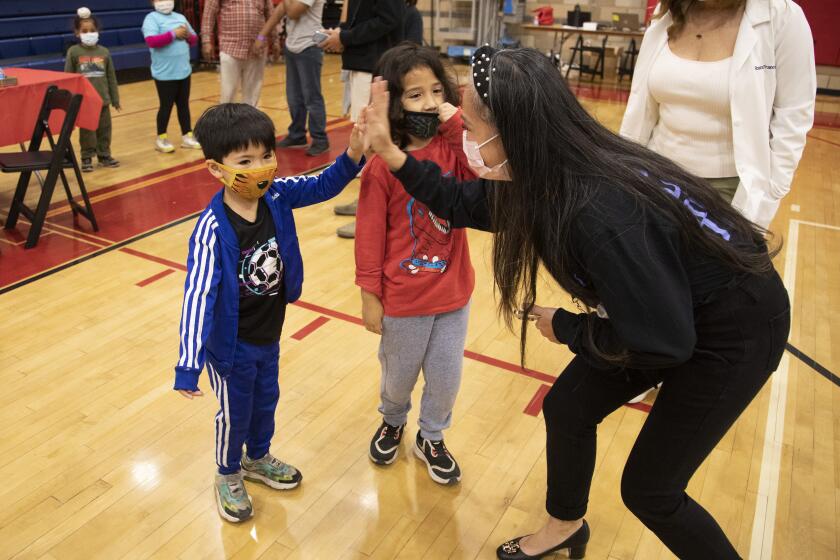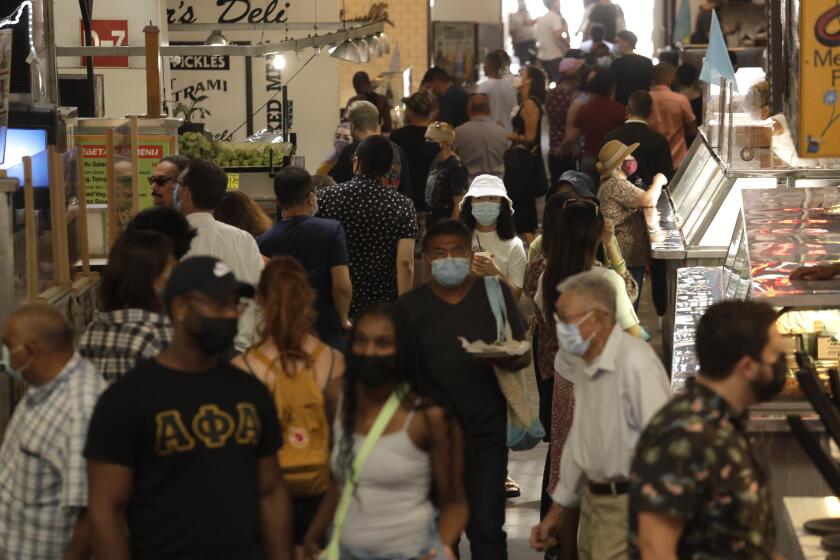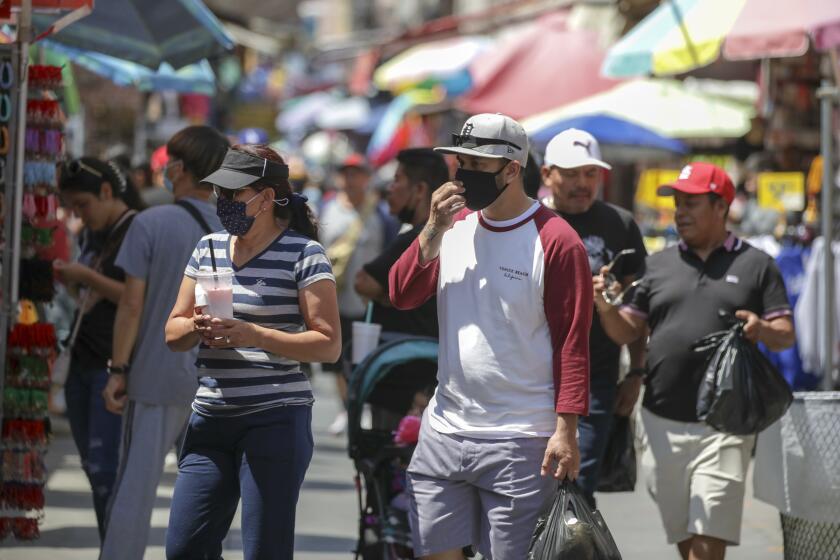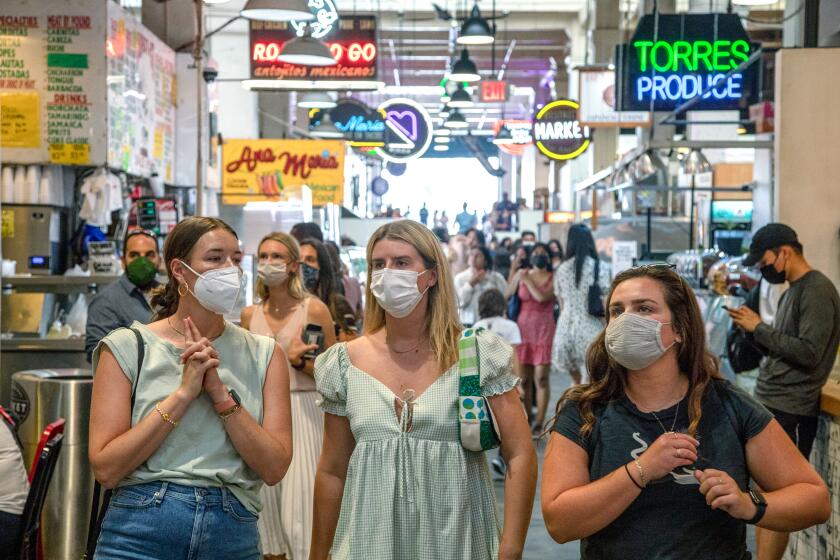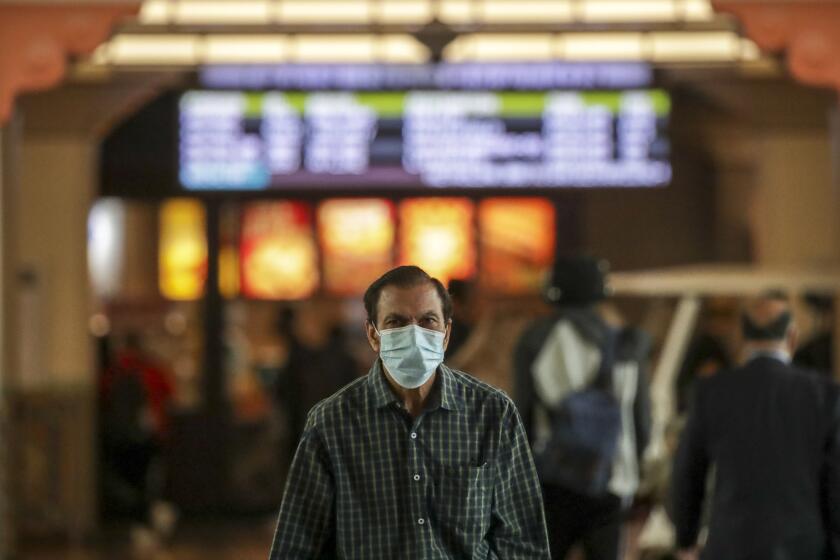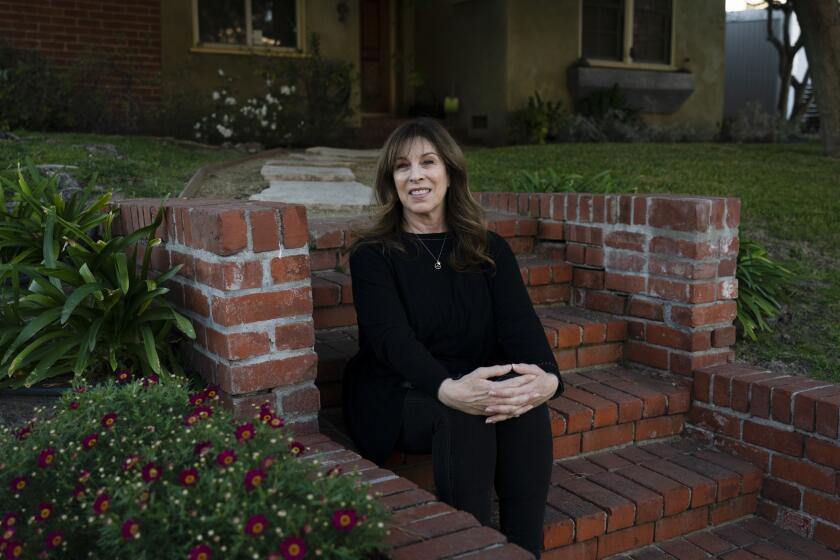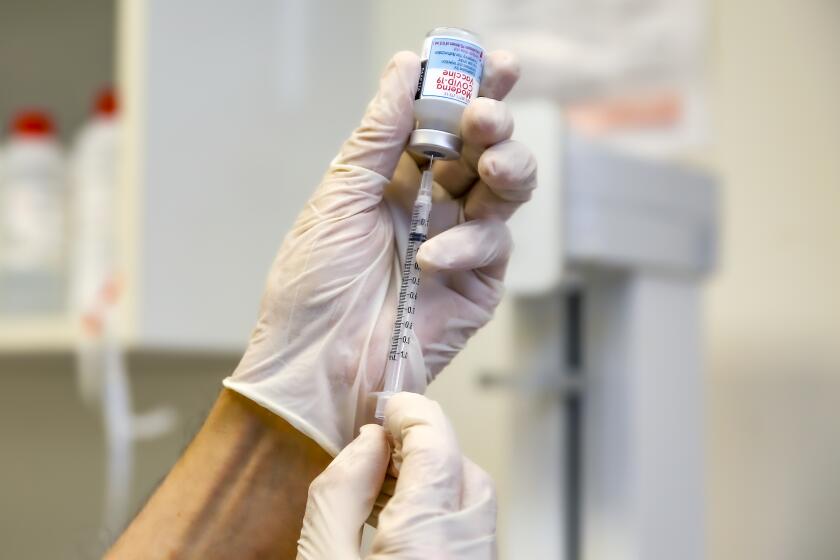L.A. County reports 12th pediatric COVID death. How to keep kids safe as school begins
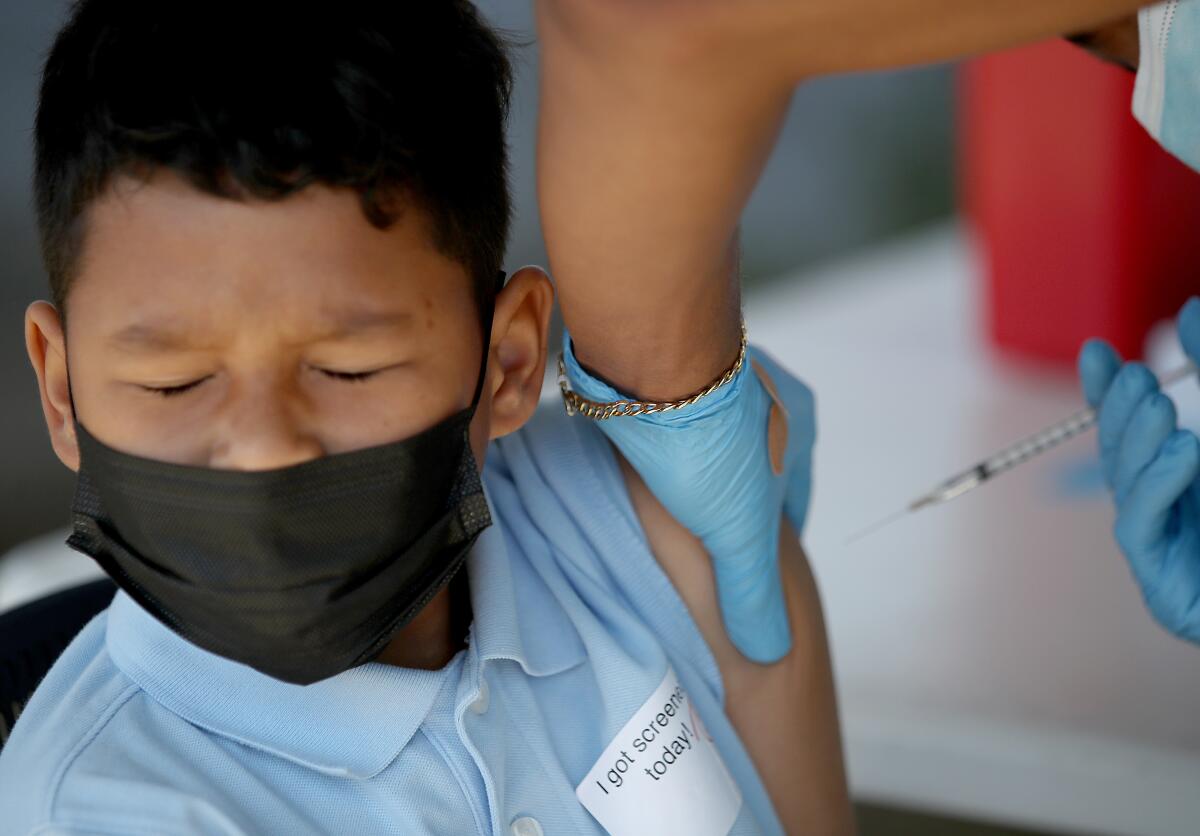
As summer vacation draws to a close, health officials are urging parents to get their children vaccinated against COVID-19, with some warning that the start of the school year could bring an increase in cases.
Infections and hospitalizations are declining after a prolonged summer wave, but that progress could be challenged as schools reopen.
This will be the first time during the pandemic that the traditional school year will begin in California without a statewide school mask mandate in place, and vaccination rates — though robust for the general public — are low among children.
While COVID-19 deaths are rarer among youth than among adults, they do happen. Los Angeles County on Friday reported its 12th COVID-19 death in a person under age 18.
“COVID-19 is here to stay, but we have learned methods and gained tools to decrease its impact on our health and wellbeing,” the state Department of Public Health wrote in its latest guidance for schools. “California’s schools can manage this disease in sustainable and adaptive manners.”
COVID-19 safety measures will mirror county requirements, a step back from more aggressive protocols on testing, masking and vaccinations.
Among the strategies state health officials recommend are ensuring that students and staff stay up to date on vaccinations, improving indoor air quality, promoting good hand hygiene and supporting access to testing.
“Not only do vaccinations provide individual-level protection, but high vaccination coverage reduces the burden of disease in schools and communities and may help protect individuals who are not vaccinated or those who may not develop a strong immune response from vaccination,” the guidance states.
About 41% of 5- to 11-year-olds in California have received at least one vaccine dose, according to data compiled by The Times.
The figure is roughly the same for both Los Angeles and Orange counties. By comparison, among 12- to 17-year-olds, 87% in L.A. County have received a dose, while 74% have in Orange.
Vaccination rates are higher in the San Francisco Bay Area. In San Francisco, 83% of 5- to 11-year-olds have had at least one dose, as have more than 90% of 12- to 17-year-olds.
Many of us suffer from pandemic fatigue. But with COVID-19 an ongoing menace, it’s time for all of us to step up and not skimp on precautions.
“I’m predicting that after the kids come back to school ... we probably will have another wave in early fall,” Dr. Clayton Chau, director of the Orange County Health Care Agency, said at a briefing Thursday. He noted that the number of children vaccinated in Orange “is quite low, like every other county.”
Chau said he thinks there will be “perhaps, God forbid, another wave in the winter.”
“We can’t predict whether or not we’ll have another variant, and whether or not the new variant is going to be more severe and more transmissible than others,” he said.
While coronavirus cases and hospitalizations have dropped, COVID-19 deaths remain on the rise and aren’t likely to decrease for some time.
There’s a possibility of a small increase in cases as the academic year begins — especially at elementary schools, due to the lower vaccination rates — but there are ways to reduce risk, said Los Angeles County Public Health Director Barbara Ferrer.
“I think everybody knows what we can do to create as much safety as possible in schools, so that children can have all of the learning opportunities that they need,” she said, noting that it would be prudent to continue wearing masks indoors in schools. “Masks do work, and they work well. And this would be an appropriate, time-limited approach to [add] in a layer of protection when transmission rates are still high.”
The California Department of Public Health also strongly recommends masking in indoor public settings.
While L.A. County is still contending with substantial coronavirus spread, it is slowing. Officials reported an average of 4,700 new cases a day over the past week, down 17% from the prior week. The latest per capita weekly case rate is 327 for every 100,000 residents; a rate of 100 or more is considered high.
Earlier this week, there were fewer than 10 new coronavirus-positive hospital admissions for every 100,000 residents of L.A. County, according to the U.S. Centers for Disease Control and Prevention; by Thursday it had ticked up to 10.1. That keeps the county in the “high” community transmission level as defined by the CDC. A rate of less than 10 would allow L.A. County to enter the “medium” category.
“We do remain hopeful” that L.A. County will soon exit the high level, Ferrer said.
Given the declining case counts and improved hospitalization rates, county health officials have ruled out reinstating an indoor mask mandate.
Los Angeles County will not reinstitute a universal indoor public mask mandate after marked improvements in the region’s coronavirus case and hospitalization rates.
Overall, 1,206 coronavirus-positive patients were hospitalized across L.A. County’s 92 hospitals as of Thursday. That’s down about 9% from the apparent peak of the wave, two weeks ago. About 43% of those patients are hospitalized with COVID-associated illness, health officials estimate; the remainder are coronavirus-positive but are in the hospital for unrelated reasons.
The percentage of emergency room visits in L.A. County associated with COVID-19 is also decreasing, as are the number of outbreaks at nursing homes and homeless shelters and the number of workplaces reporting clusters of cases.
“The California Department of Public Health reports that overall hospital admissions have peaked across the state, including in Southern California,” Ferrer said. “Their modeling predicts further declines in hospital admissions, along with some plateauing and fluctuations throughout the month of August.”
Deaths related to COVID-19, however, are increasing. Over the week that ended Friday, L.A. County recorded 121 COVID-19 deaths, the most since the end of March. This is the byproduct of earlier increases in cases and hospitalizations, and it will likely take some time before deaths begin to decline, as other metrics have.
The latest pediatric COVID-19 death in L.A. County, announced Friday, was in a patient between the ages of 12 and 17. There have been seven COVID-19 deaths in L.A. County among that age group, three among 5- to 11-year-olds and two among those younger than 5.
A pediatric COVID-19 death is defined as occurring in someone who suffered symptomatic disease before dying or had pathologic evidence of a coronavirus infection in the heart, lung or other tissues during an autopsy.
Orange County has reported five COVID-19 deaths among children under 18. One who died was a previously healthy, unvaccinated teenager who suffered from multisystem inflammatory syndrome, which can be a deadly complication of COVID-19, according to an interview her father gave to KCBS-TV.
California overall has reported 73 pediatric COVID-19 deaths: 48 among 5- to 17-year-olds and 25 among those younger.
Emerging evidence suggests that catching the coronavirus a second time can heighten long-term health risks.
Meanwhile, some California counties are exiting the high COVID-19 community level — the worst on the CDC’s three-tier scale.
The number of counties with a high community level has dropped over the past two weeks from 50 to 28. As of Thursday, 74% of Californians lived in counties with a high level, down from 83% a week earlier and 99% the week before that.
Those that most recently exited the high level are Sacramento, Kern, Tulare, Marin, Butte, Yolo, Shasta, Yuba, Tehama, Siskiyou, Amador, Mariposa and Trinity. A week earlier, Riverside, San Bernardino, Santa Barbara, Placer, San Luis Obispo, El Dorado, Nevada, Calaveras, Lassen, Del Norte, Colusa, Plumas and Inyo exited the high level.
Much of coastal Southern California remains in the high level, including San Diego, Orange and Ventura counties. So too are most counties in the Bay Area, along with some highly populated counties in the San Joaquin Valley, including Fresno, San Joaquin and Stanislaus.
As unprecedented numbers of Omicron subvariants continue to fuel a new coronavirus wave, there is growing alarm about long COVID, in which symptoms or increased risk of illness can persist for months or even years.
Statewide, there were about 14,500 coronavirus cases a day during the week to Thursday, down 18% from the week prior. On a per capita basis, that’s 260 cases a week for every 100,000 residents.
In the past week, there were 293 deaths. In early June, there were weeks when there were fewer than 200.
The Omicron subvariants BA.5 and BA.4 continue to worry health officials, because both have shown the ability to reinfect people who have recovered from older Omicron subvariants or earlier coronavirus strains, such as Delta.
According to the CDC, BA.5 made up an estimated 85.5% of new cases nationwide for the week ending July 30. BA.4 was a distant second, at 7.7%.
But officials also are closely watching a new Omicron subvariant, BA.4.6. A descendant of BA.4, it has made up only 1% of coronavirus samples in L.A. County but is attracting attention because “it’s accelerating at a similar rate as BA.5,” Ferrer said. “The question is really whether it’s going to outcompete BA.5 and really start taking over.”
Nationwide, an estimated 4.1% of cases were most recently attributed to BA.4.6 — up from 2.3% in early July, CDC figures show.
“We’re paying attention to it,” Ferrer said. “We’re watching it carefully, because it looks like it’s got some advantages in the rate at which it is proliferating. We’ll just have to see.”
U.S. regulators say they are no longer considering authorizing second COVID-19 booster shots for all adults under 50 this summer.
A different Omicron subvariant, BA.2.75, which raised concerns in India, has yet to make an impact in L.A. County. Only one case has been identified, “and this is an encouraging sign that this strain is not gaining dominance in L.A. County like it did in India,” Ferrer said.
Ferrer said there’s an expectation that boosters that are designed specifically against BA.5 and BA.4 may become available perhaps as early as next month. It’s unknown, however, whether eligibility for the Omicron booster will be restricted by age or other criteria.
More to Read
Sign up for Essential California
The most important California stories and recommendations in your inbox every morning.
You may occasionally receive promotional content from the Los Angeles Times.
